 Social Interaction.
Video-Based Studies of Human Sociality.
Social Interaction.
Video-Based Studies of Human Sociality.
2019 VOL. 2, Issue 2
ISBN: 2446-3620
DOI: 10.7146/si.v2i2.113197
Social Interaction
Video-Based Studies of Human Sociality
"You just took the jump too slowly”: A single case analysis of a mountain bike crash
Mike Lloyd
Victoria University of Wellington
Abstract
Two online videos are used to analyse social interaction in a mountain bike crash. The first provides context and a contrasting case: we view five mountain bikers taking a large gap jump in quick succession, where it is the fact that they are closely linked that helps establish the minimum speed required to take the jump. Then there is a detailed analysis of a frequently viewed YouTube video showing another group of five riders with a very different experience of a much smaller gap jump. In this case, only two riders are closely linked and we see a different kind of social effect: a watching group encourages one of the riders to take the gap jump solo, when he does not seem to have the necessary skill. As a result, when he attempts the jump, he is knocked unconscious. The analysis shows how coordinated activity does not always benefit participants, which highlights the need to carefully investigate the subtleties of co-operative action.
Keywords: mountain biking, flow file, crash, co-operative action, pedagogy, accountability
1. Introduction
This study offers an ethnomethodological analysis based mainly on a single mountain biking video that has had almost four million views on YouTube. Such a precise focus reflects the longstanding policy of “ethnomethodological indifference”, i.e. ethnomethodologists can study an “indefinitely large domain of appropriate settings” because the key interest is in “the managed accomplishment of organized settings of practical actions” (Garfinkel, 1967: 32). Thus, the topic per se is relatively unimportant, as analytical cogency is determined by how closely we can capture the essence of a particular activity (Liberman, 2013). In this case, the activity is mountain biking, as made available by videos taken in-situ by a member.
My entry into this world was very simple. As a mountain biker, as well as riding tracks, I often view online videos of mountain biking, including what are called ”fail” videos. These show mountain bikers crashing while riding, with consequences ranging from mere embarrassment to serious injury. As an ethnomethodologist, one such video stayed in my mind: it was a naturalistic video with a highly interactive aspect with regard to the mountain biking and the serious crash featured therein. Hence, I began a single case analysis, as indicated in the paper’s title, the first part of which - ”you just took the jump too slowly” – is taken from a participant’s account of a crash during a ”gap jump”. The place of this account within a stream of activity is described below, the analytical emphasis being that visible scrutiny is an important part of mountain biking as a community practice with its own pedagogical and accountability practices. What happens during the gap jump is a kind of “co-operative action” (Goodwin, 2017). This is double-edged. It can be joint activity from which the individual riders can derive benefit, but there can also be significant risks, including crashes like the one focused on here.
The article has four sections. Firstly, there is a brief outline of Goodwin’s work on “co-operative action”, and mountain biking history. The latter leads to the description of gap jumps as a mountain bike structure, which is important in the second and main section, in which there is a description and analysis of one single video showing five riders taking a gap jump, during which one of them has a serious crash. Finally, there is a brief conclusion summarizing the analysis.
2.1 Co-operative action
Bringing together a number of his well-known empirical analyses, Goodwin’s recent book (2017) on “co-operative action” provides a useful frame of reference for the following analysis. In the introduction Goodwin explains the importance of the hyphen in “co-operative” first, to mark that what is being examined is not the same as cooperation as it is investigated in much important research in fields such as biological anthropology (though there is a strong family resemblance between the two perspectives, in that both focus on how people build action by working together), and second, to emphasize the importance of performing specific operations (most importantly decomposition and reuse with transformation) on materials provided by another. (2017: 6)
Language is clearly a paradigm case of co-operative action, but Goodwin emphasizes that such actions are by no means restricted to language. He gives the materiality of tools as an example, the wider point being that social actions are “constructed by combining different parts to create a whole that cannot be found in any of the parts in isolation” (3).
Such holism can produce collective benefit, but it does not always do so. As Goodwin argues, when studying co-operative action we should remain agnostic about mutual benefit for, and solidarity between, the participants. On this view we do not need “psychological functionalism”, for what is being focused on are not psychological states that make human cooperation possible, but instead public social practices that human beings pervasively use to construct in concert with each other the actions that make possible, and sustain, their activities and communities. (2017: 7)
The focus on communities means that we need to be attentive to the work of building competency amongst members. This means that “pedagogy”, both formal and informal, is a key topic in sociological analysis. Below, we will look at co-operative action in a specific mountain biking activity, focusing on how action is built around specific operations on provided materials, trying to understand the social practices, including pedagogy, that sustain the community of mountain bikers. Consistent with Goodwin, the interesting result of the analysis is that co-operative action sometimes has negative effects for participants, a point often overlooked in micro-sociological emphases on negotiation, order-construction and the like.
2.2 Mountain biking context
Off-road cycling in the form of cyclo-cross has existed as an organized sport since the 1940s, but it is generally accepted that mountain biking began in the late 1970s (Eassom, 2003). In the early days, mountain bikers rode on gravel roads that acted as firebreaks and were on hilly terrain, but by the early 1990s, as the sport grew in tandem with improvements in bike technology, sole-use mountain bike tracks on public land, or dedicated mountain bike parks, were established. For the purpose of this analysis, two features of this historical development are relevant: firstly, mountain biking frequently became a joint activity, carried out by groups of riders as opposed to solo riders[i]; secondly, standard structures were built into mountain bike tracks, both by riders themselves and by the growing number of companies who specialized in constructing mountain bike tracks. Amongst these structures is the gap jump featured in the crash analysed below.
Before describing this crash, we can view screen snaps from another video in order to give the reader a feel for mountain biking as a group activity, the nature of a gap jump, and how it can be ridden. Figures 1 and 2 are taken from a video[ii] made by staff from the Australian Mountain Bike magazine who were recording their visit to an extensive mountain bike park in New Zealand. Extract 1 covers both clips.
”Be Rude Not To” YouTube video available at: https://youtu.be/ZBpVEeIIU-M
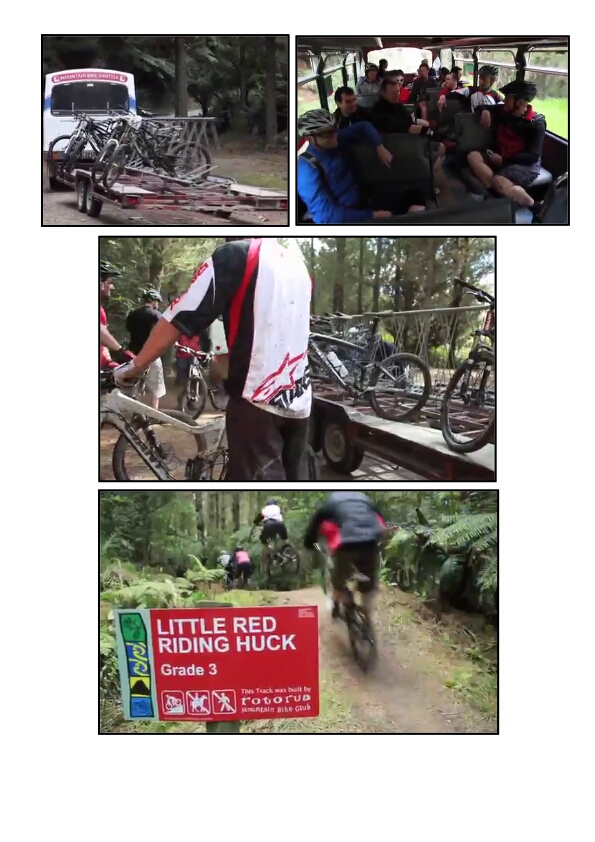
Figure 1. Off the bus and into a flow file
Figure 1 shows mountain biking as a social activity. In the first three panels, we see a group of riders transported via a shuttle bus to an area where they disembark, and then begin to ride various downhill tracks. The fourth panel shows that when the riders make their way onto the tracks, rather than making their own choice about which track to ride and then riding individually, they ride as a group. We see four members of the group riding on a named track and most of the video similarly shows the group riding together.
A key point to note here is how close together the group are: although each rider is on their own bike and controls this individually, in effect they are almost a single entity, as each rider is aware of the others and strives to keep the chain together. Such chains can be referred to using Lee and Watson’s (1993) term “flow file”, i.e. “one or more persons following another immediately preceding person/persons … where some person adopts the position of ‘pathfinder’ and becomes the first in a serial format of people that moves along with the flow” (1993: 91). Flow files can dissolve during the riding of any particular track, but there is a very good reason for trying to maintain a close linkage. This is illustrated in figure 2, a series of screen snaps taken from the video a short while after the riding seen in figure 1.
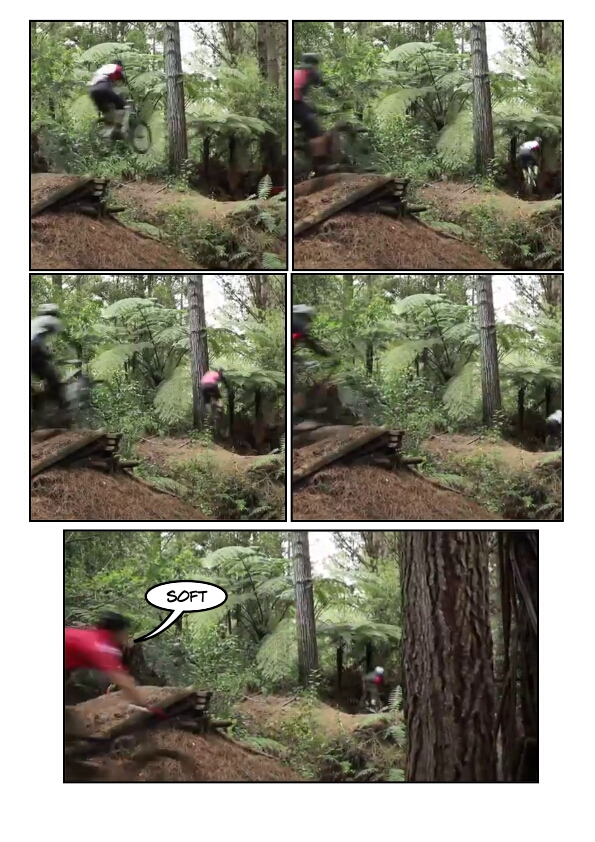
Figure 2. Flow file at gap jump
Figure 2 covers four seconds from the video during which five of the riders cross a gap jump. This is a structure which, in effect, consists of a hump with the middle part removed, or which has a natural dip, creating three parts: a takeoff ramp, a gap where the rider “gets air”, and a landing. As seen in panel 5, the last rider veers off to the side of the jump, riding what is called a “chicken line”, exclaiming “soft” as he does so. This exclamation, and the fact that mountain bikers call this a “chicken line”, shows a normative aspect in operation. That is to say that very skilled mountain bikers should ride a gap jump through the air. If a rider does take this option, there is a distinct benefit to being in a flow file. This particular jump spans several metres, meaning that there is a minimum speed required for clearance. Therefore, if the first rider in a flow file successfully clears the gap, they make manifest there and then the minimum speed (notwithstanding the need to use correct jumping technique).
Of course, mountain bikers can take on gap jumps solo, but if the required speed is shown by the first rider in a flow file, this can reduce hesitancy in following riders. Acting in concert with others gives rise to a pre-conceptual and intuitive bodily engagement with the world (see Laurier, 2010; Meyer & von Wedelstaedt, 2017), producing a kind of ‘just do it’ situated logic. But, as we will see below, this holistic effect is always contingent: flow files are not always established, and even if they are, they can lengthen and their benefits can be lost, and any rider can pull out (or crash) at any time. However, it is worth noting that once a flow file is established, any variance becomes “accountable”, as the “soft” exclamation by the fifth rider illustrates. Below, we will see this accountability at work in the specific case study.
3.1 Description of “Rider Knocked Unconscious” Video
The video was first posted on YouTube in October 2015, and at the time of writing has logged over 3.7 million views and 5,740 comments. The poster – Tim Rowsell – included a brief description, as follows:
Out for a ride in the Surrey Hills and after climbing to the top hit record on the video to hit the first small set of doubles. Walked back up the track towards the start when a few other guys came down. Unfortunately the last one down nosedived into the gap and went over the bars and landed literally face first. … Rider was unconscious for a few minutes and then after slowly coming around was very confused. The total time from accident to taken away in the ambulance was over an hour, so this is cut down. (from Rider knocked unconscious, 2015)
It is not clear from the video which members of the group of riders know each other, however, this lack of knowledge makes no material difference to the following analysis.[iii] The editing of the video is also not a disadvantage as the key part of interest to me has not been edited in any way (the first editing cut comes at 10:21). Rowsell’s summary above gives the gist of what happened, but it is useful to provide more detail as given in Table 1.
| Table 1. Summary of "Rider Knocked Unconscious" video | |
|---|---|
| Video Time | Action |
| 0 - 0.06 | Black screen with "Mountain bike "Over the bars" crash. Rider knocked unconscious. 17.10.2015 Surrey Hills" |
| 0.06 - 0:25 | Helmet mounted camera on RC shows him riding along a wooded track, over a gap jump (0:10), stopping (0:14) and walking back to stand alongside the jump, looking towards jump approach |
| 0:25 - 0:32 | Two riders (R2, R3) appear. R2 clears the jump (0:28) but R3 brakes and rolls through the jump bypass (0:30), then talks with RC about his "failure" |
| 0:32 - 0:40 | R4 appears, clears the jump, laughter from him as he rides off the track into undergrowth, RC turns to see his position, then turns back to the jump approach |
| 0:40 - 0:45 | R5 appears, crests jump (0:43) but then his front wheel dips, hitting the ground before clearing the jump. He catapults head first over handlebars, landing face first on the other side of the gap jump |
| 0:45 - 0:46 | "Fuck" exclamation from RC as R3 and R4 rush to R5's body, face down beside his bike |
| 0:46 - 1:15 | Unconscious R5 is helped; RC instructs R3 to ring 999 |
| 1:15 - 10:21 | R5 receives attention from the group who wait for ambulance to arrive. First signs of R5 coming around at 3:28, but as he is able to answer questions it is clear he does not remember what happened |
| 10:21 - 12:43 | Ambulance arrives, medics attend to R5, get him on stretcher, carry him to ambulance |
| 12:43 - 12:47 | Black screen with "Andy was given the all clear later on in hospital and was back at work 2 days later. Remember …" |
| 12:47 - 12:57 | "Wear a helmet" superimposed over views of R5's broken helmet; video ends |
As indicated by the labelling of the riders, in the part of the video focused on, there are five mountain bikers in action. RC’s helmet-mounted camera (probably a GoPro) is the source of the video and therefore provides his perspective. The vast majority of the talk in the video comes from when the group are helping R5 (1:15 to 12:43), and is clearly audible. The intention below is not to take a conversation analytic approach to the talk, rather the focus on “co-ordinated action” means that a “graphic transcript” (see Laurier, 2014) presentation style is ideal (readers would also benefit here from viewing the video through the provided link). We will now look at pre- and post-crash events using a number of these graphic transcripts.
3.2 Co-operative Action Prior to the Crash
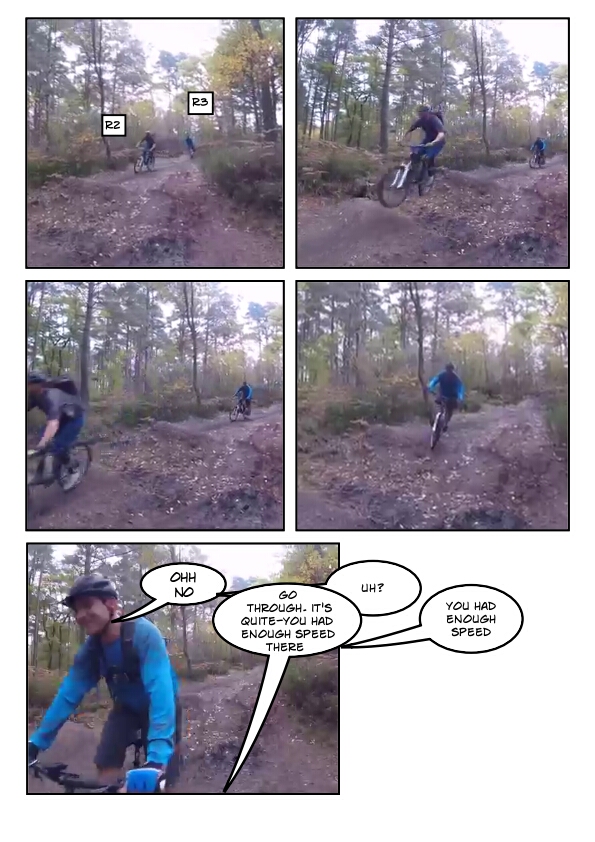
Figure 3. R2 and R3 at the gap jump
Figure 3 collates five screen snaps from 25 seconds into the video. Prior to this point, RC has ridden along the track, cleared the gap jump, then stopped and walked his bike back up. The track is not particularly steep, nevertheless there is sufficient downward slope for the riders not to have to pedal (at a guess they are moving at about 15 to 20 kilometres per hour). Just as RC is at the gap jump, R2 and R3 appear, and RC stops to watch them riding. In contrast to the riding seen in figure 2, where the filming has been purposely set up to capture the group of riders at the gap jump, it seems fortuitous that RC is alongside the gap jump when R2 and R3 appear. Nonetheless, he clearly stops to watch, which shows that the gap jump is marked as a space in itself: it is part of the whole track, but it is an identifiable (and nameable) feature requiring specific skills, hence the riding there can be scrutinized in terms of competency within a community of practice.
This endogenous evaluation of competency is exemplified in the contrast between R2’s and R3’s riding of the jump as seen in figure 3. The former clears it comfortably, and because the two are riding in a flow file, R3 can see that he also has sufficient speed to clear the gap. Despite this, in panels 4 and 5 we see that R3 brakes just before the takeoff ramp, then rolls through the muddy bypass (the track marks suggest that many riders take this “chicken line”). Then, as he nears the stationary RC, he says “oh no”; these words and his facial expression clearly express disappointment at not having attempted the jump. RC tells R3 to ride past him – “go through” – and it is very clear from the repetition of “you had enough speed” that a pedagogical practice is occurring. Furthermore, this is grounded in the visible riding, rather than more distant knowledge or experience: RC’s “lesson” to R3 does not come in reference to his own clearance of the jump - R3 has not seen this - rather, what is key is that R2 and R3 have been in a flow file (albeit the smallest form of such). Consequently, both RC and R3 have seen R2 clear the jump, and both know that R3 was riding at the same speed as R2, justifying the sensibility and repeatability of the comment “you had enough speed there”. These visible and known features are central to the way in which this social action is ongoingly ordered as it is conducted (a familiar point of emphasis for ethnomethodologists).
What happens next adds another interesting dimension to this pedagogical gathering at the gap jump.
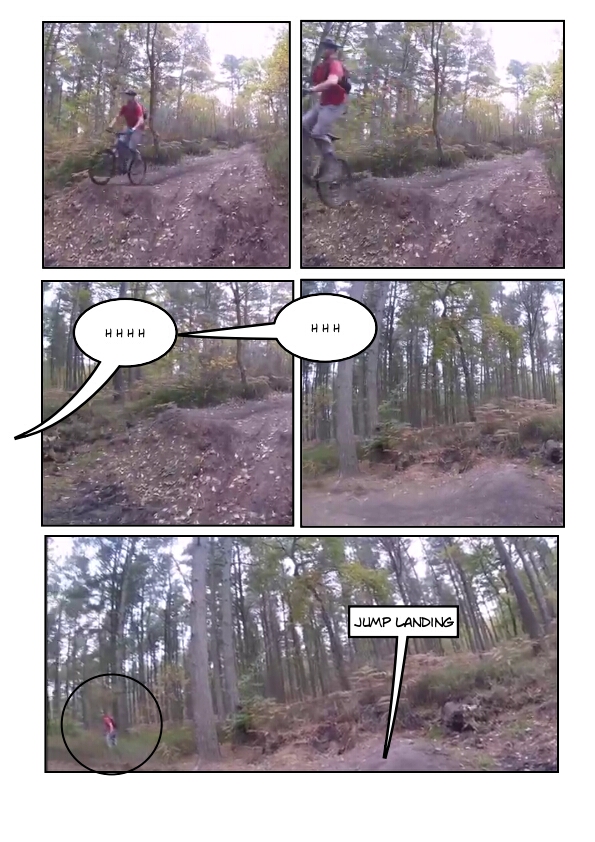
Figure 4. R4’s partial success
Just as RC says “you had enough speed” the first time, R4 appears on the track, riding solo, and approaches the gap jump. As RC repeats “you had enough speed”, R4 crests the takeoff ramp (panel 1), gaining good “air” in the jump, but then there is a fairly loud sound from his landing (not seen). As RC turns to follow his progress, R4 emits laughter, and we see that post-landing he has gone off the track and into the undergrowth (panel 5). Hence, he has not been fully successful in riding the gap jump. Despite this partial failure there is no comment from RC or R3, however, R4’s laughter, along with expressing relief, seems to do the communicative work of recognizing that something went wrong in his riding of the jump. RC then turns back to the jump to see R5 approaching, also riding solo.
3.3 The Crash
It is important to consider what R5 can see in front of him as he approaches the gap jump. Because R5 is not filming his ride, we can only build a visible record of this by using a screen snap from RC’s ride as a useful approximation of what R5 sees. By carefully scrutinizing the video we can accurately estimate the location of the other riders as R5 nears the jump, as shown in figure 5.
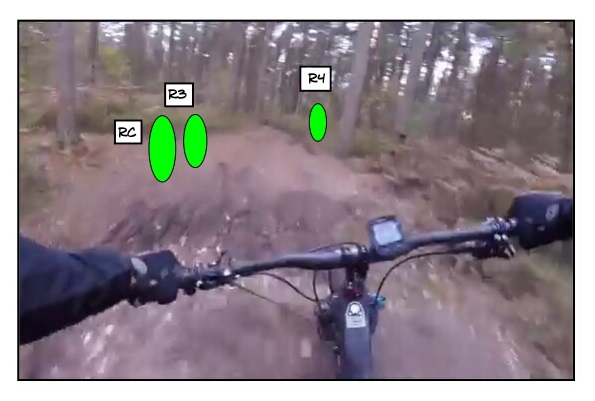
Figure 5. Position of riders as R5 approaches the gap jump
Note that R2 is not represented in the figure. He is stopped some distance ahead and is probably not visible to R5, although the other members of the group clearly are. As noted above, whereas R4 has gone off into the undergrowth he is only a matter of a few metres from the jump, and is most probably visible to R5. Certainly, RC and R3 constitute a significant presence for R5. They are both stopped to the left side of the jump, close to where a rider taking the “chicken line” would proceed. This by no means “forces” R5 into the jump, but it could well contribute to a “moment of salience”, that is, the sudden emergence of a path to take (see Liberman, 2013: 20; Lloyd, 2017b: 692).
To avoid the “persistent problems” of attempting to pinpoint causation in social science (see Hammersley, 2014), we need to be cautious about falling into causal language when considering this moment. In my view, one alternative is the rarely used word “educe”: with the other riders gathered in front of him, R5 is educed into taking on the gap jump. Unfortunately, being drawn in like this has harmful consequences, as we so graphically see from figure 6.
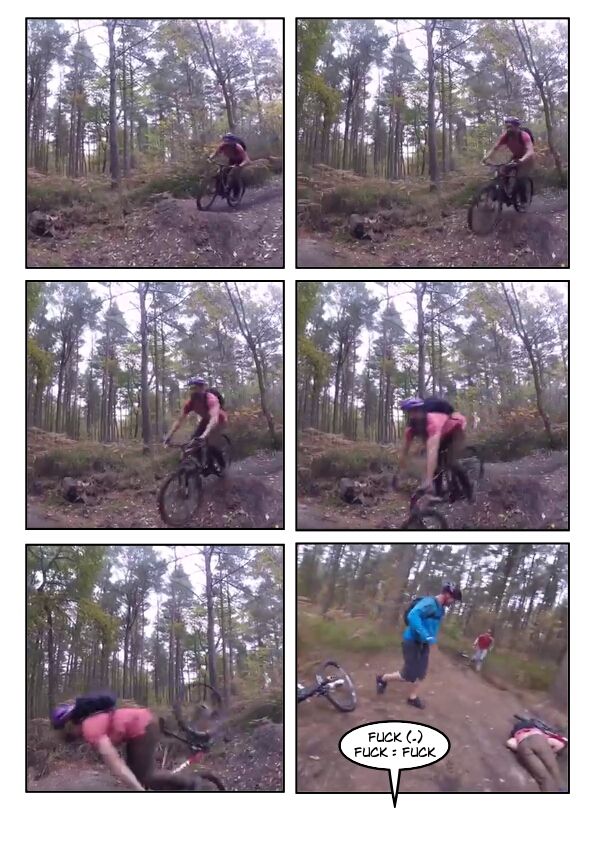
Figure 6. R5’s “endo”
Panel 1 of figure 6 shows R5 at the takeoff ramp. If readers watch the video carefully, they will notice two things. Firstly, just prior to this point R5 makes a slight adjustment in his line; secondly, compared to the previous riders he has a slower pace and a lower centre of gravity on his bike. Panels 2 and 3 show that almost immediately upon leaving the takeoff ramp his front wheel dips, and panel 4 shows the disastrous consequence: his front wheel lands inside the exit side of the jump, with the momentum of his body and the rest of the bike catapulting him over the front wheel (in mountain biking jargon called an “endo”, short for end over end). He lands face first, as seen in panel 6.
Immediately, RC shouts, “fuck (.) fuck=fuck”, and R3 and R4 rush to R5’s prone body. R4 lifts the bike away from R5, while R3 begins to turn him over. All we hear from R5 is a heavy breathing sound, just like snoring. RC quickly insists that R5 be left on his side, and instructs R3 to “call 999 now”, as it is clear that R5 has been knocked unconscious in the heavy face-first landing. At this point, R2 rejoins the riders and they are now all together and attending to R5.
3.4 Post-crash account
It takes several minutes for R5 to regain consciousness. The gathered group – RC, R2, R3 and R4 – coordinate their activities, and eventually an ambulance arrives and R5 is taken away on a stretcher.
As noted, there is much talk during this period, but what I want to focus on is the account of the crash, with part of this process illustrated in figure 7.
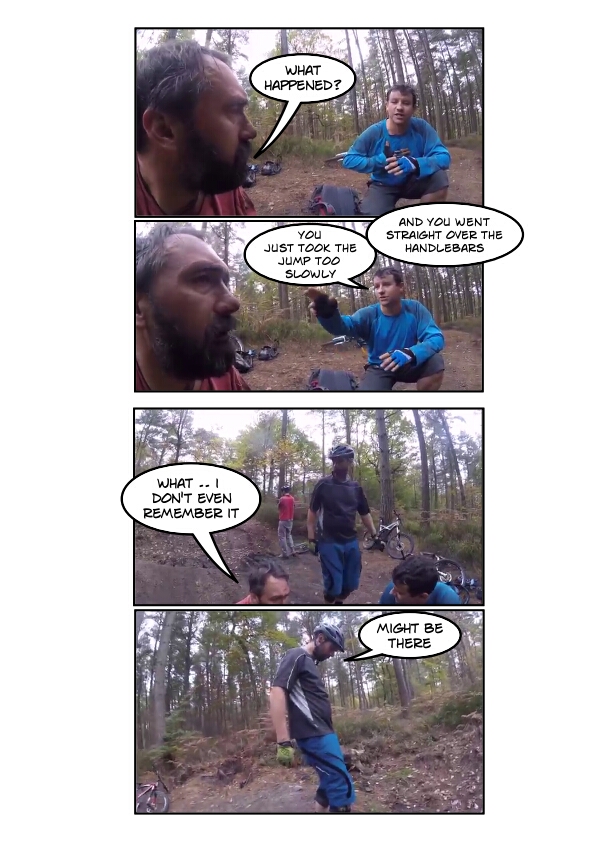
Figure 7. The inclusion of the site in the post-crash account
As R5 regains consciousness he sits up, begins talking, and as shown in panel 1, asks, “What happened?” (the third time he has asked this). R3 has no trouble formulating his account. Pointing to the jump he says, “You just took the jump too slowly ... and you went straight over the handlebars”. The prefacing “just” does important work in suggesting that the explanation for the crash was simple, visible and clear to all. Part of the reason why R3 can offer this account without a second thought is because of his prior pedagogical co-operative action with RC, i.e. RC’s proffered evaluation that R3 “had enough speed there”. There is interesting “projective” temporal work going on here. Just moments prior to this, RC has informed R3 that his speed could have been projected forwards, meaning that he could have successfully crossed the jump, as seen by R2’s prior clearance. Now, in accounting for R5’s crash, “you just took the jump too slowly” provides a seamless explanation for the crash and becomes the most fitting account. It is also perhaps a more socially palatable account than, for example, “you didn’t have enough speed”. Either way, lack of speed becomes the natural way of accounting for R5’s crash, even though other factors – poor technique, mechanical failure - are available; these do not necessarily contradict the need for minimum speed, but they could supplement or elaborate this dominant account. It is also worth noting that due to his period of unconsciousness, R5 is literally unable to offer his own account of what happened: he has no recall and asks “what happened?” four times.
As seen, the other riders who witnessed the crash quickly respond, and on all four of these occasions the same account – too slow - is offered. But it is also worth noting that this account does not just take the form of talk, but occurs at the site of the crash, and therefore the jump itself becomes part of this account, as shown in Figure 7. In panel 3, just over a minute on from panel 1, RC is facing towards the jump partly because R4 has indicated that the ambulance has arrived from this direction. Again R5 says “what” which is foreshortened, then goes on to say, “I don’t even remember it”. RC offers the too-slow account, simultaneously moving to the landing side of the jump, at which point R2 moves in (panel 4) and indicates with his foot and downward gaze, “might be there”. RC responds, “Yeh, no it was down there, it was literally that one there”, and then R3 repeats “and you just went straight over”. Hence, the riders collectively elaborate on the too-slow account by pointing to the evidence in the dirt of the gap jump itself; in their view, they can locate precisely where R5’s front wheel landed, catapulting him into the endo that knocked him unconscious.
It should be noted that at no point in this seamless account is there any mention of the fact that at least three of the group watched R5 take on the jump. It would be a brave sociologist who was prepared to talk of this social factor having caused R5’s crash, on the other hand, neglecting the material presence of the other riders visibly gathered in front of R5, would be to “miss the forest for the trees”. Clearly, the participants do not have the luxury of slowing down a video recording while they are doing what they are doing, but we should not underestimate the detail that a skilled practitioner can notice, especially given that RC and R3 stopped to watch the action at the gap jump. The relevance of this can be shown by considering figure 8, which juxtaposes the riding of R4 and R5 at the point of “liftoff” at the gap jump.
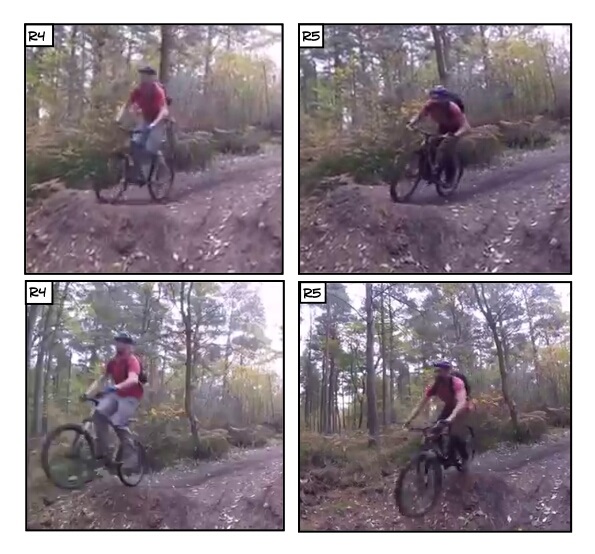
Figure 8. Comparison of R4 and R5 at the gap jump
R4 has good speed, but a competent mountain biker can see that, in effect, he has tried too hard to lift his bike up (actually a “pump” off the takeoff ramp). This has brought his back wheel down lower than the front one, resulting in the hard landing on the back wheel, after which he goes off the track and into the undergrowth.
In contrast, R5 noticeably crouches down over his bike, failing to pump off the takeoff ramp. Consequently, his front wheel is immediately travelling in a downward trajectory, leading to the endo. The interesting point to raise here is that even if R5 had been travelling at a faster pace, his poor technique may still have resulted in a bad landing/crash. The point is, it is quite possible that the gathered riders could have seen this poor technique; but with R5 recovering in front of them it is hardly appropriate to criticize his riding technique. Instead, the too-slow account prevails, and because of this there is no need to draw attention to the possible importance of the presence of three mountain bikers in front of him, witnessing his riding competence. It is therefore no surprise that the video ends with a “lesson” that does not mention this social aspect. The black screen at the end presents the safer reminder, “remember … wear a helmet”, superimposed over views of R5’s helmet broken in his endo.
4 Conclusion
There are hundreds of mountain biking crash videos posted online, but I hope that I have provided enough detail above to justify this single case analysis. In just a few minutes, the video affords varied and rich access into the world of mountain biking as a social phenomenon. The innocuous looking gap jump has been seen to be, to use a somewhat neglected phrase from Garfinkel’s work, a powerful “organizational thing”. That is to say that for the mountain bikers, the gap jump
although it is of their doing, and as of the flow they are “witnessably oriented by” and “seeably directed to” the production of it, they treat the organizational thing as of their doing, as of their own doing, but not of their very own, singular, distinctive authorship. And, further, for just this cohort [the group of riders] it will be the case that after they exit the freeway [gap jump], others will come after them to do the same thing again, familiar things that they – just they – just these of us as drivings [ridings] doings are in concert doing. (Garfinkel and Wieder 1992, 204, fn 3, original emphasis)
This mirrors Goodwin’s point in insisting on the hyphen in co-operative action, as it emphasizes “the importance of performing specific operations … on materials provided by another” (2017: 6).
These repeated operations will often proceed mundanely. However, given the social dynamics at play there is also a strong likelihood of further crashes occurring. This is not just because the combination of a gap jump and moving on a mountain bike is a dangerous thing, but also because there is an endogenous logic to the practice. In short, whether riding singly or with others, mastery of the practice is the goal, rather than plain competence. The pursuit of mastery comes at the cost of risking crash and injury.
Sometimes social organization can aid the pursuit of mastery. We saw this most clearly in the functioning of the flow file: in how, by riding closely linked with others, a fearless “just do it” mindset can prevail. We can infer that this is partly what explains RC repeating “you had enough speed” when R3 pulled out of the jump. Being the second person in a flow file where the first has cleared the jump, seems to be part of the reason for RC’s pedagogical advice to R3. Interestingly, the justifiably key importance of minimum speed then featured moments later in the account proffered after R5’s crash, once he regained consciousness and asked “what happened?” Here, R3 had no hesitation in passing on the lesson. Collectively, the group of riders establish minimum speed as a first principle for the mountain biker’s task of getting to the other side of the gap jump.
Nevertheless, other accounts and lessons could have been given. Even for someone unfamiliar with mountain biking, the comparison offered in figure 8 showed an obvious difference in technique between R5 and another rider. However, apart from speed, “poor technique” was not offered to R5 to explain his crash, perhaps to avoid adding insult to injury. Rather than speculate about this, the key point to be taken is to highlight the other social force that we have seen in operation. That is, if it is accepted that R5 is not a skilled jumper, the question follows of why he took on the jump, and there is an obvious candidate answer visible in the video recording: as he approached the jump he had three other riders gathered in front of him watching him take on the jump. In contrast to the precedent offered when riding in a flow file, R5 had no one to show him the requisite minimum speed, and in this case the effect of the gathering seems to have been a different “just do it” force, one that ended disastrously. Hence we can see the usefulness of analysing “co-operative action”, without assuming that there will always be beneficial outcomes.
Acknowledgements
My thanks to the two referees and the editors for their useful comments. Thanks also to Max Baddeley, Dylan Taylor and Annemarie Jutel for discussing my analytic thoughts on mountain biking. Thanks to Gregg Brown for permission to copy the video “Be Rude Not To”.
References
“Be Rude Not To” YouTube video available at: https://www.youtube.com/watch?v=ZBpVEeIIU-M
Goodwin, C. 2017, Co-operative Action. Cambridge: Cambridge University Press.
Eassom, S. 2003, “Mountain Biking Madness.” In To the Extreme: Alternative Sports, Inside and Out, edited by R.E. Rinehart and S. Sydnor, pp. 191-203. Albany: State University of New York Press.
Garfinkel, H. 1967, Studies in Ethnomethodology. Englewood Cliffs: Prentice Hall.
Gafinkel, H., & D.L. Wieder. 1992, Two Incommensurable, Asymmetrically Alternate Technologies of Social Analysis. In Text in Context: Contributions to Ethnomethodology, edited by G. Watson and R.M. Seiler, pp. 175-206. Newbury Park: Sage.
Hammersely, M. 2014, The Limits of Social Science: Causal Explanation and Value Relevance. London: Sage.
Laurier, E. 2010, Driving: Pre-cognition and Driving. In Geographies of Mobilities, edited by P. Merriman and T. Cresswell, 69-81. Abingdon: Taylor & Francis.
Laurier, E. 2014, “The Graphic Transcript.” Geography Compass 8 (4): pp. 235-248.
Lee, J.R.E. & Watson, D.R. 1993, Final Report: Interaction in Urban Public Space. Paris: Plan Urbain.
Liberman, K. 2013, More Studies in Ethnomethodology. Albany: SUNY Press.
Lloyd, M. 2017, a. “Skills to Pay the Bills.” Sites, Vol.12 No. 2,pp. 51-76.
Lloyd, M. 2017, b. “When Rules Go Awry.” Human Studies Vol. 40 No. 4,: pp. 681-706.
Meyer, C. & U. Von Wedelstaedt (2017), (Eds.), 2017. Moving Bodies in Interaction – Interacting Bodies in Motion. Amsterdam: John Benjamins.
”Rider Knocked Unconscious” YouTube video available at: https://www.youtube.com/watch?v=ek4yFrMvjMo